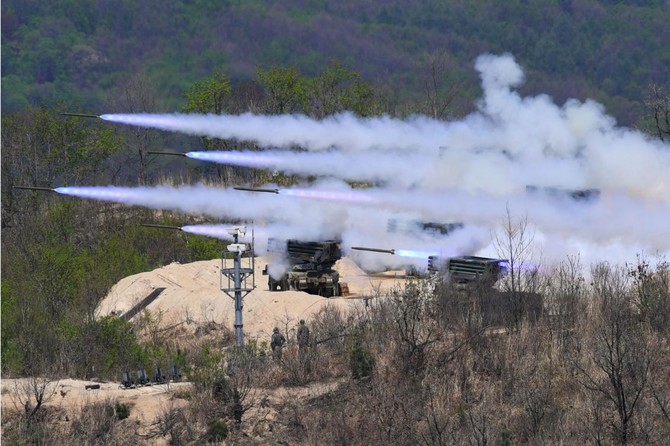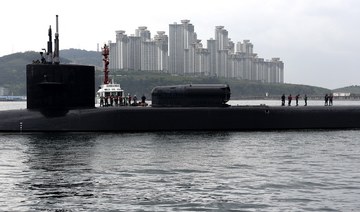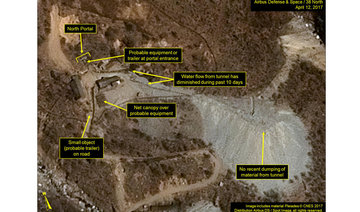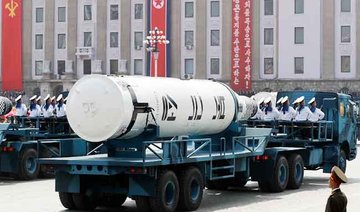SEOUL: US troops began delivering a missile defense system that has infuriated China to a deployment site in South Korea Wednesday, amid heightened tensions over the North’s nuclear ambitions.
Washington is urging Beijing — Pyongyang’s sole major ally — to do more to rein it in, but the Asian giant has reacted with fury to the planned installation of the Terminal High Altitude Area Defense (THAAD) system.
The US and ally South Korea say its deployment, agreed last year, is intended to guard against missile threats from the nuclear-armed North.
But China fears it will weaken its own ballistic capabilities and says it upsets the regional security balance. It has imposed a host of measures seen as economic retaliation against the South, including a ban on tour groups.
TV footage showed large trailers in camouflage paint carrying what appeared to be missile-related equipment entering a former golf course in the southern county of Seongju on Wednesday morning.
Hundreds of residents — who are concerned over the potential environmental impact — protested angrily, some clashing with police. More than 10 were injured including three who were hospitalized, activists said.
Seoul’s defense ministry said Wednesday’s move was aimed at “securing operational capability of the THAAD as soon as possible,” with a goal of fully installing the batteries by the end of this year.
The South is holding a presidential election next month to choose a successor to ousted leader Park Geun-Hye, and Seoul and Washington are pressing ahead with the deployment with some candidates expressing ambivalence over the system, including front-runner Moon Jae-In, of the left-leaning Democratic Party.
His spokesman Park Kwang-On expressed “strong regret” at the delivery, saying it ignored “required procedures.”
“This move has shut off any room for policy considerations by the next government and it is very improper,” he said.
The South’s tourist industry has been hammered by Beijing’s boycott over THAAD, with Chinese visitor numbers — normally more than half the total — plummeting 40 percent last month even though the ban only came into force on March 15.
Retail conglomerate Lotte — which previously owned the Seongju golf course and provided it to the Seoul government in a land swap — has also been targeted, with 85 of its 99 stores in China shut down.
South Korea’s biggest automaker Hyundai Motor said Wednesday its Chinese sales fell 44 percent last month.
THAAD is designed to intercept and destroy short and medium-range ballistic missiles during their final phase of flight.
The latest move comes as tension soars on the Korean peninsula following a series of missile launches by the North and warnings from the administration of US President Donald Trump that military action was an “option on the table.”
Washington has deployed an aircraft carrier strike group led by the USS Carl Vinson to the peninsula in a show of force, amid signs the North could be preparing for a sixth nuclear test.
The impoverished, isolated state says it needs nuclear weapons to defend itself against the threat of invasion, and has issued blood-curdling promises of retaliation in the event of an atomic strike against it.
In Pyongyang’s latest display, leader Kim Jong-Un oversaw the country’s largest-ever firing drill to mark the founding anniversary of its military, state-run media said Wednesday.
The joint drill saw more than 300 large-calibre self-propelled guns firing simultaneously and torpedo attacks by submarines, state-run KCNA said, demonstrating the country’s determination to a “pour merciless rain of fire on the reckless imperialist US and its dirty followers,” it said.
Seoul held a large annual drill of its own Wednesday, involving some 100 artillery pieces, 90 armored vehicles and 50 aircraft, as well as 2,000 South Korean and US troops, the defense ministry said.
The US has long pushed for China to make more efforts to curb Pyongyang’s behavior.
But Beijing says it has less sway over its wayward neighbor than Washington believes.
It is also concerned that a regime collapse could trigger a flood of refugees across the border, and leave the US military on its doorstep in a unified Korea.
Chinese President Xi Jinping called Monday for “restraint” regarding North Korea in a telephone conversation with Trump.
US defense leaders and other top officials are to give a classified briefing on North Korea to all senators in an unusual meeting at the White House later Wednesday.
US missile defense equipment reaches S.Korea site
US missile defense equipment reaches S.Korea site

Chinese premier agrees with Australia to ‘properly manage’ differences

- Australia shares US concerns over China’s global dominance in critical minerals and control over supply chains in the renewable energy sector
Li, Albanese and senior ministers of both administrations met at Parliament House on Monday to discuss thorny issues, including lingering trade barriers, conflict between their militaries in international waters and China’s desire to invest in critical minerals.
Li, China’s most senior leader after President Xi Jinping, arrived in the South Australian state capital of Adelaide on Saturday and the national capital of Canberra late Sunday in the first visit to the country by a Chinese premier in seven years.
Li told reporters said after Monday’s meeting that the bilateral relationship was “on the right track of steady improvement and development.”
“We ... had a candid exchange of views on some differences and disagreements and agreed to properly manage them in a manner befitting our comprehensive strategic partnership,” Li said through an interpreter.
Albanese described the discussions as “constructive.”
“Australia advocates that we should all work together to promote a regional balance where no country dominates and no country is dominated,” Albanese said.
“I’ve made it clear as nations with different histories, political systems and values, we will cooperate with China where we can, disagree where we must and engage in the national interest,” Albanese added.
Bilateral relations have improved markedly since Albanese’s center-left Labour Party was elected in 2022 following nine years of conservative government in Australia.
Most of the official and unofficial trade barriers Beijing introduced in 2020 on coal, cotton, wine, barley and wood have been lifted since Albanese was elected.
Beijing had banned minister-to-minister contacts as it froze out the previous Australian government diplomatically.
Agriculture Minister Murray Watt said before the leaders’ meeting Monday that he would raise the issue of China’s ban on Australian rock lobsters and exports from two beef processing plants.
“The mere fact that we have the first visit by a Chinese premier, the second-most powerful person in China, ... since 2017 is an enormous opportunity to continue that dialogue, to continue stabilizing our relationship and address some of the outstanding issues,” Watt said.
Li planned to underscore China’s interest in buying a bigger stake in Australia’s critical minerals sector, which is essential to the global transition to renewable energy sources, by visiting a Chinese-controlled lithium processing plant in Western Australia state Tuesday.
Li visited New Zealand before Australia and is scheduled to stop in Malaysia late Tuesday before returning to China.
Australia shares US concerns over China’s global dominance in critical minerals and control over supply chains in the renewable energy sector.
Citing Australia’s national interests, Treasurer Jim Chalmers recently ordered five Chinese-linked companies to divest their shares in the rare earth mining company Northern Minerals.
Watt said Chinese investment was not banned from the sector, but must meet national security criteria.
Albanese’s office said the prime minister would tell Li at a state lunch that the “points on which we disagree won’t disappear if we leave them in silence.”
This appears to be in response to a statement by Li, released by the Chinese Embassy in Canberra on Sunday, that he recommended “shelving differences” between the two countries in the interests of bolstering relations.
Earlier, Albanese had said he would raise with Li recent clashes between the two countries’ militaries in the South China Sea and Yellow Sea that Australia argues endangered Australian personnel.
Relations tumbled over Australian legislation that banned covert foreign interference in Australian politics, the exclusion of Chinese-owned telecommunications giant Huawei from rolling out the national 5G network due to security concerns, and Australia’s call for an independent investigation into the causes of and responses to the COVID-19 pandemic.
Benjamin Herscovitch, a China expert at Australian National University, said he did not expect China to get any firm commitments from Australia during Li’s visit.
But Australia had already made a concession to China in rebuilding relations through inaction by not imposing sanctions on Chinese entities that help Russia’s war effort in Ukraine, he said.
“Australia is essentially giving China a free pass on that issue,” Herscovitch said, while Australian allies, including the United States were imposing sanctions.
Hundreds of pro-China demonstrators, human rights activists and democracy advocates have lined the routes of Li’s cavalcades in Adelaide and Canberra.
Thousands of Rohingya feared trapped in fighting in western Myanmar

- Residents of Maungdaw town, inhabited primarily by the Rohingya, told to leave ahead of a planned offensive by the Arakan Army against Myanmar ruling junta forces
Tens of thousands of Muslim minority Rohingya are feared to be caught in fighting in western Myanmar, as a powerful armed ethnic group bears down on junta positions in a coastal town on the country’s border with Bangladesh.
The Arakan Army (AA), which is fighting for autonomy for Myanmar’s Rakhine region, said late on Sunday that residents of Maungdaw town, inhabited primarily by the Rohingya, should leave by 9 p.m. ahead of a planned offensive on the settlement.
The AA’s attack on Maungdaw is the latest in a months-long rebel onslaught against the Myanmar junta, which took power in a February 2021 coup, and now finds itself in an increasingly weakened position across large parts of the country.
“We are going to attack the remaining posts” of junta, the AA said in a statement, asking residents to stay clear of military positions in Maungdaw for their own safety.
A junta spokesman did not respond to a call seeking comment.
Around 70,000 Rohingya who are currently in Maungdaw are trapped as the fighting draws closer, said Aung Kyaw Moe, the deputy human rights minister in Myanmar’s shadow National Unity Government.
“They have no where to run to,” he told Reuters.
Thousands of Rohingya fled toward neighboring Bangladesh last month, seeking safety from the escalating conflict, although the neighboring country is reluctant to accept more refugees.
Their movement was triggered by battles in and around the town of Buthidaung, around 25 km (15 miles) away to the east of Maungdaw, that was captured by the AA after intense fighting during which the rebel group was accused of targeting the Rohingya community.
The AA denies the allegations.
Rohingya have faced persecution in Buddhist-majority Myanmar for decades. Nearly a million of them live in refugee camps in Bangladesh’s border district of Cox’s Bazar after fleeing a military-led crackdown in Rakhine in 2017.
Norway gives $103 million to Ukraine to secure electricity

- Norwegian PM says the fund will go toward repairs in the Kharkiv area
- Kharkiv has been hit particularly hard by Russian attacks recently
OSLO: Norway said Sunday that it would provide 1.1 billion kroner ($103 million) to Ukraine to help repair its energy infrastructure and secure the country’s electricity supply before next winter.
“Russia is carrying out massive, systematic attacks to paralyze the power grid, but Ukrainians are working day and night to maintain essential electricity supplies for the population,” Prime Minister Jonas Gahr Store said in a statement.
According to new estimates, more than 50 percent of Ukraine’s power production capacity has been destroyed, the government said.
“We are in close dialogue with Ukraine on how it can use these funds most effectively. The Ukrainians themselves have the best insight into what is needed,” Store said, adding that it was important to begin infrastructure repairs before the onset of winter.
Norway said it had already been decided that 120 million kroner would go toward repairs in the Kharkiv area, which has been hit particularly hard by Russian attacks recently.
Solar panels will be installed at seven maternity units and operating theaters in the Kharkiv area, Store said in the statement, which was issued as he attended a Ukraine peace summit in Switzerland.
In 2022, Norway provided 2.1 billion kroner in funding to the Ukrainian energy sector, and 1.9 billion kroner last year.
The Scandinavian country has pledged 75 billion kroner in military and civilian aid to Ukraine for the five-year period 2023-2027, with funding allocated each year in line with Ukraine’s needs.
Philippine ship, Chinese vessel collide in South China Sea: Beijing

- China's coast guard says “Philippine replenishment ship ignored many solemn warnings from the Chinese side”
- China has been trying to force a Philippine troops stationed in one of the disputed reefs by blocking supply missions
BEIJING: A Philippine ship and a Chinese vessel collided near the Spratly Islands in the disputed South China Sea on Monday, Beijing’s Coast Guard said.
Beijing claims almost the entirety of the South China Sea, brushing aside competing claims from several Southeast Asian nations including the Philippines and an international ruling that its stance has no legal basis.
China deploys coast guard and other boats to patrol the waters and has turned several reefs into militarised artificial islands. Chinese and Philippine vessels have had a series of confrontations in disputed areas.
On Saturday, new Chinese coast guard rules took effect under which it can detain foreigners for alleged trespassing in the disputed sea.
Beijing’s coast guard said in a statement Monday that a “Philippine replenishment ship ignored many solemn warnings from the Chinese side.”
It “approached the... Chinese vessel in an unprofessional way, resulting in a collision,” the statement said.
Beijing accused the ship of having “illegally broken into the sea near Ren’ai Reef in China’s Nansha Islands,” using the Chinese name for the Spratly Islands.
“The Chinese Coast Guard took control measures against the Philippine ship in accordance with the law,” it added.
Manila has accused the Chinese coast guard of “barbaric and inhumane behavior” against Philippine vessels, and President Ferdinand Marcos has called the new rules a “very worrisome” escalation.
China has defended its new coast guard rules. A foreign ministry spokesman said last month that they were intended to “better uphold order at sea.”
China Coast Guard vessels have used water cannon against Philippine boats multiple times in the contested waters.
There have also been collisions that injured Filipino troops.
The Group of Seven bloc on Friday criticized what it called “dangerous” incursions by China in the South China Sea.
The South China Sea is a vital waterway, where Vietnam, Malaysia and Brunei also have overlapping claims in some parts.
Most recently, however, confrontations between China and the Philippines have raised fears of a wider conflict over the sea that could involve the United States and other allies.
Trillions of dollars in ship-borne trade passes through the South China Sea annually, and huge unexploited oil and gas deposits are believed to lie under its seabed, though estimates vary greatly.
Biden pushes Gaza ceasefire deal in Eid message

- The US has been pressing Israel and Hamas to formally accept the ceasefire deal greenlighted by Security Council members last week
WASHINGTON: President Joe Biden used his Eid Al-Adha message to Muslims to advocate a US-backed ceasefire deal in Gaza, saying Sunday it was the best way to help civilians suffering the “horrors of war between Hamas and Israel.”
“Too many innocent people have been killed, including thousands of children. Families have fled their homes and seen their communities destroyed. Their pain is immense,” Biden said in a statement.
“I strongly believe that the three-phase ceasefire proposal Israel has made to Hamas and that the UN Security Council has endorsed is the best way to end the violence in Gaza and ultimately end the war,” he added.
The United States has been pressing Israel and Hamas to formally accept the ceasefire deal greenlighted by Security Council members last week, which would allow an initial six-week pause to fighting.
Eid Al-Adha, which marks the prophet Ibrahim’s willingness to sacrifice his son to God, saw a rare day of relative calm in Gaza after Israel announced a “tactical pause” in fighting near Rafah to facilitate aid deliveries.
The president highlighted American efforts to “advocate for the rights of other Muslim communities” facing persecution, including the Rohingya in Myanmar and the Uyghurs in China.
He said “we’re also working to bring a peaceful resolution to the horrific conflict in Sudan,” which has been gripped by fighting between the country’s army and a rival paramilitary group since April 2023.
On the domestic front, Biden’s message Sunday also promised a crackdown on Islamophobia in a direct appeal to American Muslims, a key voting demographic in the Democrat’s reelection bid against Republican rival Donald Trump.
“My Administration is creating a national strategy to counter Islamophobia and related forms of bias and discrimination, which affect not only Muslims, but also Arab, Sikh, and South Asian Americans,” Biden said.




















